Published on August 9, 2022 by Shweta Gupta
Oncology is considered to be the most dynamic area of therapy in terms of innovation, considering the increasing number of clinical trials and companies investing in cancer therapeutics, the size of the pipeline of therapies in the clinical phase of development, the novel drug substances being launched and the increasing investment in oncology globally.
This blog covers the size of the oncology drugs market, market dynamics, drivers, trends, challenges and the latest developments within the oncology space.
Global Oncology Drugs Market Revenue
The global oncology drugs market was valued at USD176.1bn in 2021 and is projected to reach USD320.6bn by 2026, growing at a CAGR of 13.25%.
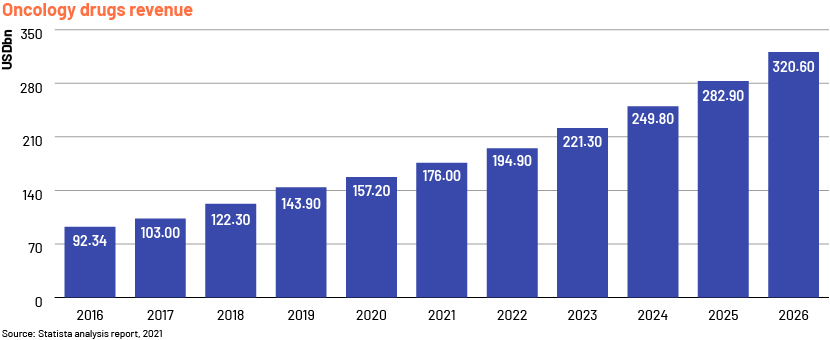
Market segmentation and best-selling drugs: The oncology market is segmented primarily based on diagnostics, treatment, indication and region.
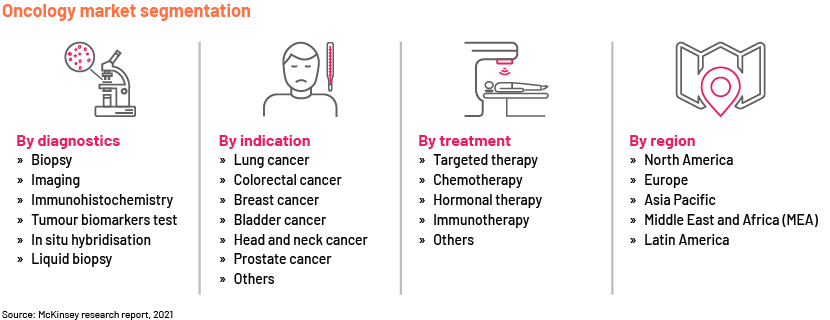
Keytruda, Humira and Eliquis are expected to be the three best-selling drugs by 2024.
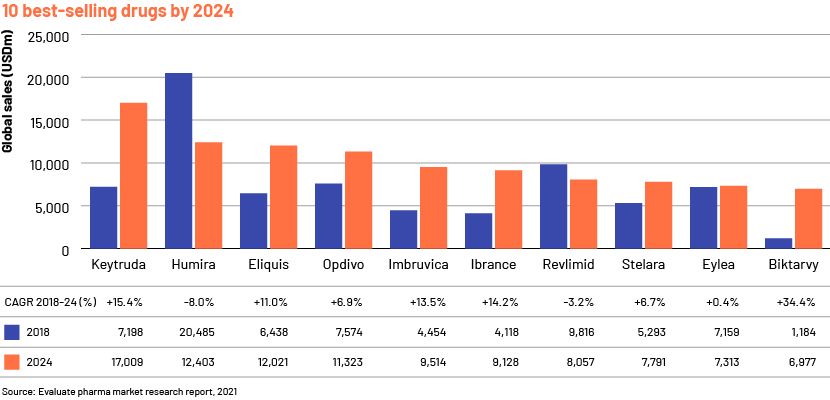
Market Dynamics – Key Drivers:
-
Factors driving the global oncology drugs market include the increase in the geriatric population, increasing incidence of cancer, early diagnosis and screening of cancers and increasing R&D for cancer therapeutics, which are often analyzed through healthcare market intelligence., which are often analyzed through healthcare market intelligence.
-
Promising drugs in the late stage of the pipeline, combined with high potential in emerging economies
-
Strong technological advancements and rising concern over high death rates due to cancer
-
Introduction of new therapies and drugs for cancer and government support to enhance healthcare facilities
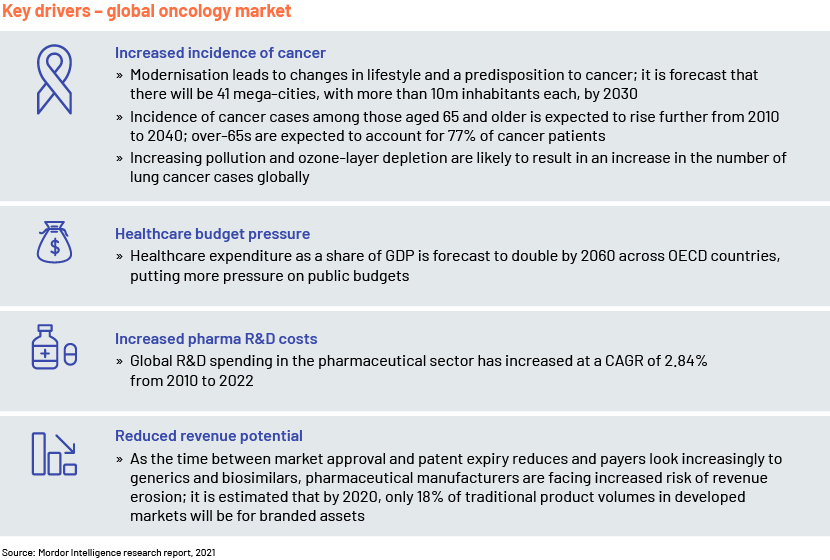
Competitive Landscape:
-
The global oncology drugs market is fragmented, with Bristol Myers Squibb, Roche and Merck dominating the space, mainly due to strong oncology product pipelines and key strategic business acquisitions
-
These companies have a wider geographical presence and are also actively involved in R&D in order to expedite regulatory approval
-
June 2022: The US Food and Drug Administration (FDA) approved Bristol Myers Squibb’s CAR T cell therapy Breyanzi for relapsed or refractory large B-cell lymphoma after one prior therapy
-
May 2022: The FDA approved Merck's Keytruda for MSI-H, dMMR endometrial cancer and Roche’s CDx
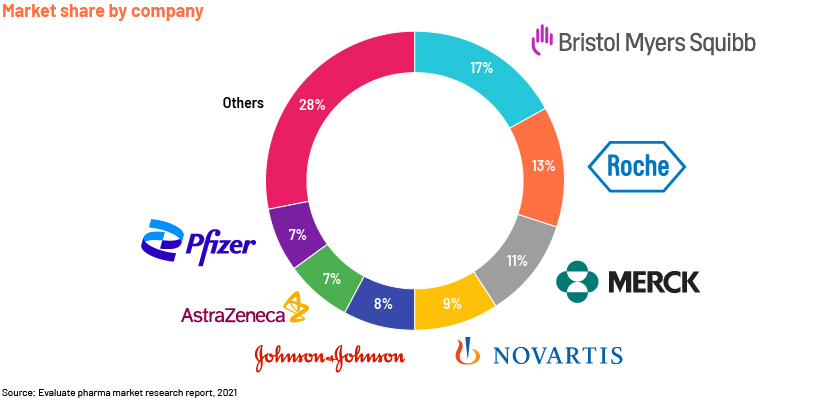
Latest Trends and Developments:
Disruptive trends and developments such as the following will likely shape the oncology space for years to come:
-
Precision medicine development will change the paradigm of next-generation sequencing: Precision medicine – delivering the right drug to the right patient at the right time – is progressing rapidly, and numerous ground-breaking precision therapies have gained approval in recent years. Moreover, the rising need for personalised therapies, higher safety and efficacy, fewer side effects than other drugs and ease of integrating with other targeted therapies will likely drive the overall use and adoption of these therapies at the global level.
-
Artificial intelligence (AI) and machine learning (ML) will become routine features of patient care: Rapid adoption of virtual modes of care including AI and ML has changed the overall method of patient care and has tremendous potential to reduce waste while driving improvements in evidence-based medicine and more efficient, smarter workflows.
-
New cell and gene therapies: The launch of new modalities including cell therapy, viral vectors, RNA therapy and stem-cell therapies has revolutionised the oncology market and changed the focus of oncologists to a value-based care model. Kymriah and Yescarta, two CAR-T cell therapies, were approved for acute lymphocytic leukaemia (ALL) and diffuse large B-cell lymphoma (DLBCL). While current CAR-T sales remain modest, several hundred active agents are being tested, with 2024 revenue forecast to surpass USD6bn.
-
Immuno-oncology combination therapies: Increasing investment in immuno-oncology combination studies, with more than 200 mechanisms now being investigated as PD-(L)1 or CTLA-4 combination partners, and immuno-oncology assets estimated to represent approximately half of the top 10 companies’ pipelines. Immuno-oncology (IO) is emerging as a novel approach to cancer treatment through the stimulation of the body’s own immune system. For example, the nivolumab + ipilimumab combination therapy for the treatment of lung cancer and the pembrolizumab + nivolumab combination therapy for the treatment of metastatic melanoma.
Latest news and recent developments: A number of significant events have occurred in the oncology space since January 2021, with important implications for drug development.
Notable events in drug approval and regulatory action
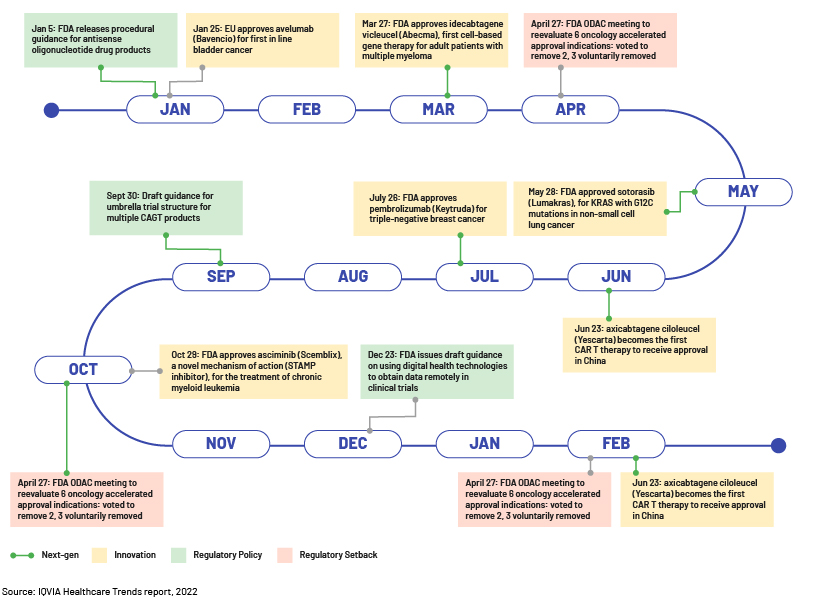
Challenges:
-
The pandemic had a negative impact on growth of the oncology market due to the delay in surgeries and administration of chemotherapy and fewer diagnoses; this remains a concern for oncologists
-
High costs associated with diagnostic imaging equipment, coupled with capital investment
-
High risk of side effects associated with cancer treatment
-
Stringent government regulations, high cost of drugs and patent expiry
Market Restraints
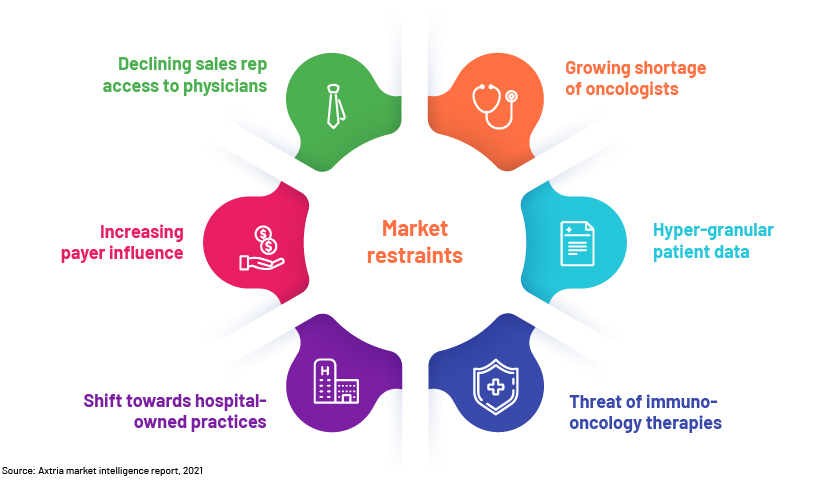
Conclusion
Although the pandemic had a negative impact on growth of the oncology market, the lifting of lockdowns and the slowing spread of infection in 2021 led to demand for novel radiation therapy technology for cancer patients, for better treatment and real-time patient monitoring. The rapid adoption of digital technologies including AI, ML and robotic process automation (RPA) has also fuelled market growth.
Global spending on cancer medicine rose to USD185bn in 2021 and is expected to reach more than USD300bn by 2026, driven by continued innovation. Growth in major markets is driven by new products and brand volume and offset by loss of exclusivity, including the biosimilar impact. Key market players are also focusing on launching new campaigns and formulating strategic plans to increase product visibility and brand awareness to remain competitive.
How Acuity Knowledge Partners can help
We are a leading provider of high-value research, analytics and business intelligence services to life sciences, bio-pharma, medtech and healthcare consulting firms.
We provide bespoke research support on market entry and due diligence, portfolio management, licensing and acquisition, go-to-market strategy, opportunity assessment, regulatory landscaping, product launch analysis, market access and therapy area assessment, indication prioritisation, market research and forecasting, pipeline analysis and benchmarking and competitive intelligence.
For more information on our capabilities, please visit our Life sciences solutions page.
Sources:
-
Delivering innovation: 2020 oncology market outlook | McKinsey
-
Landscape of Immuno-Oncology Drug Development – Cancer Research Institute (CRI)
-
Oncology Market Size to Worth Around US$ 536.01 BN by 2029 | BioSpace
-
Oncology Market Trends: Predictive Biomarkers, New IO Targets and Tougher Competition
-
https://www.oecd.org/health/health-systems/Addressing-Challenges-in-Access
-
Cancer Therapy Market Report, Analysis (2022 - 27) | Industry Size (mordorintelligence.com)
-
How Pharma Can Navigate the Shifting Sands of Oncology Treatments | BCG
-
New dynamics in the pharmaceutical oncology market (pwc.com)
Tags:
What's your view?
About the Author
Shweta Gupta has ~16 years of experience in research, consulting and advisory services. She is currently part of Acuity’s strategy research and consulting team, with experience in secondary research, business, and corporate strategy, thought leadership and competitive intelligence and benchmarking.
Prior to joining Acuity Knowledge Partners, Shweta Gupta worked with companies in the consulting, telecom and research analytics domains, where she was largely responsible for strategic research, corporate strategy, landscape study, market sizing, market entry and growth strategy, operating models, business models, opportunity analysis, company and product profiling and supplier identification.
Like the way we think?
Next time we post something new, we'll send it to your inbox










